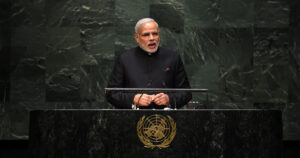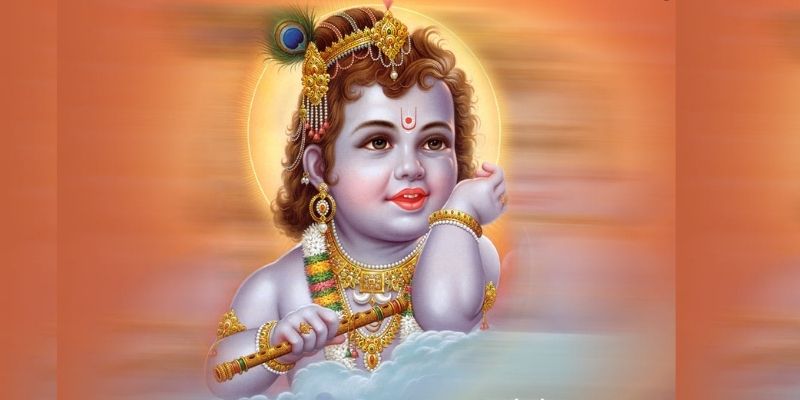
Govinda Aala re, aala!! Who’s blue, mischievous, and has an affinity for Makhan? We all know the answer to that!! Of course, we are talking about Lord Krishna. Popularly known as Shri Krishna, people know him using other names as well, such as Girdhari- one who lifted Govardhan hill, Devakinandan- son of Devaki and Vasudev, Parthasarthy- chariot rider for Arjuna, Gopal- who takes care of cows, and many other names.
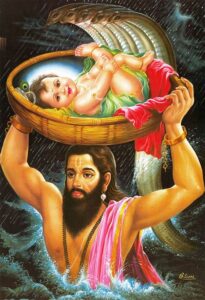 Krishna, the eighth avatar of Lord Vishnu, was born to Vasudev and Devaki in a prison cell. The history of Janmashtami goes back several millennia, and if we keep surveying, there are multiple folklores relating to Krishna and his birth. Moreover, people believe Krishna’s purpose was to make a kingdom of peace, religion, and prosperity. Mathura’s King Ugrasen had a daughter, Devaki, who married King Vasudev. However, this was not accepted by Kansa because he had a prophecy of death from one of their children. Kansa imprisoned Devaki and Vasudev, and whenever a child was born, Kansa would kill them.
Krishna, the eighth avatar of Lord Vishnu, was born to Vasudev and Devaki in a prison cell. The history of Janmashtami goes back several millennia, and if we keep surveying, there are multiple folklores relating to Krishna and his birth. Moreover, people believe Krishna’s purpose was to make a kingdom of peace, religion, and prosperity. Mathura’s King Ugrasen had a daughter, Devaki, who married King Vasudev. However, this was not accepted by Kansa because he had a prophecy of death from one of their children. Kansa imprisoned Devaki and Vasudev, and whenever a child was born, Kansa would kill them.
However, on the night of the birth of their eighth child, a divine voice asked Vasudev to ferry the child to Nandaraj, his friend. Vasudev found an exit, and with the help of Sheshanag, he was able to cross the raging Yamuna river. Before Kansa could reach their prison cell, Vasudev exchanged his newborn with Nandaraj’s daughter and returned to his wife. As Kansa tried to kill the daughter, she slipped away from him and transformed into the Goddess Durga. She foretold Kansa of his doom which would soon come true.
Krishna Janmashtami commemorates the birth of Shri Krishna, and people from every state and culture celebrate this festival. Janmashtami falls on the Ashtami or the eighth day of the Krishna Paksh or dark fortnight of Bhadon month. For Hindus, it’s one of the most important festivals, where, on the first day, people perform the Raslila (dance drama), which depicts Krishna’s life. At the stroke of midnight, prayers and pujas are performed to applaud Krishna’s deeds. Some children even dress up as Krishna and Radha. The celebrations reach their peak when people go two nights without any sleep and chant bhajans and folk songs connected to Janmashtami.
Festivities for Janmashtami have no end as almost every state and culture has its way of celebrations. Let’s look at some of the famous ceremonies in India-

- Since Krishna was born in Mathura and grew up in Vrindavan, the Braj region in Uttar Pradesh celebrates this festival like there’s no tomorrow. Devotees decorate and light temples with rangolis, flowers, and lights, making it a glittery affair. People perform Rasleelas and storytellers treat the audiences with tales from Krishna’s childhood through song or dance.
- People in Gujarat celebrate the festival similar to Dahi Handi, called Makhan Handi, especially in Dwarka, the origin of Lord Krishna’s empire. Folk dances, singing bhajans, and visiting temples such as the Dwakadhish temple of Nathdwara, are all part of the festivities in Gujarat.
- In Jammu, kite flying is one of the main festivities during Janmashtami
- Moreover, Janmashtami in Maharashtra is famous in districts like Mumbai, Pune, Nagpur, and Latur. Also known as Gokulashtami, one of the most popular festivities is the Dahi Handi. Here, they tie an earthen pot at the top where participants form a human pyramid to reach it and break it. This ritual is a symbolism of a young Krishna sneaking jars of butter from various houses.
- In South India, locals decorate their homes with kolams and draw small footsteps using rice batter, symbolizing the tiny footsteps of a young Krishna entering their home. Devotees offer sweets like payasam and laddus for pooja, with some butter.
- Janmashtami is also celebrated in countries like Nepal, Fiji, Mauritius, and Bangladesh.
Although Krishna was named ‘Makhanchor’, his love for eating was immense. Any dairy product, available in Vrindavan, was finished by Krishna and his mates. However, for this festival, there are certain delicacies that you must try, those are-

- Panjiri is one of the vital ‘prasadam’ of this festival, and people believe this delicacy to have a good effect on the intestines. It’s prepared with coriander seed powder, ghee, sugar, and assorted dry fruits and is popular in Uttar Pradesh, Bihar, Punjab, and several others.
- Some consider Maakhan Mishri as Lord Krishna’s favourite. It’s easy to prepare and consists of butter and sugar.
- One of the most traditional drinks during Janmashtami is honey and milk, which is considered a symbol of purity.
- Gopalkala, also known as ‘poor man’s food’, is offered to Krishna during midnight prayers. It’s a simple dish consisting of cucumbers, beaten rice, curd, coconut, sugar, ghee, and cumin seeds. Originating in Maharashtra, it’s offered as a prasad in almost every household.
- Furthermore, Panchamrit is a milk mixture consisting of milk, ghee, curd, jaggery, and tulsi leaves. Its use is to bather Lord Krishna at midnight, and once the devotees complete the ritual, they distribute the Amrit among themselves as a prasadam.
There are also a few other treats like Kheer, Basundi, Nariyal Barfi & Laddu, Besan Laddu, Ragi Laddu, Sabudana Thalipeeth, Masala Bhaat & kadhi, and Gulab Jamun that make this truly a festive time.
Janmashtami is near, and we hope you have reserved your energy for the celebrations. We wish everyone a happy and safe Krishna Janmashtami!!


 Moreover, Raksha Bandhan falls in the auspicious month of
Moreover, Raksha Bandhan falls in the auspicious month of 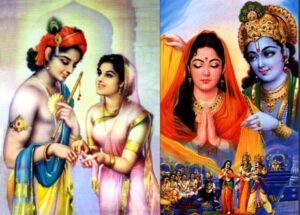 In a war between demons and gods, Demon King Brutra was advancing, and Gods lead by lord Indra were on the verge of defeat. After approaching Guru Brihaspati for advice, Lord Indra tied a sacred thread on his wrist powered by divine incantations. Lord Indra’s Queen Sanchi (Indrani) empowered the filament and tied it to his hand, leading them to victory.
In a war between demons and gods, Demon King Brutra was advancing, and Gods lead by lord Indra were on the verge of defeat. After approaching Guru Brihaspati for advice, Lord Indra tied a sacred thread on his wrist powered by divine incantations. Lord Indra’s Queen Sanchi (Indrani) empowered the filament and tied it to his hand, leading them to victory.


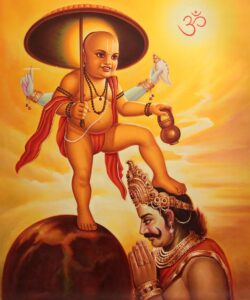 However, the history of Onam is unique. According to folklore, King Mahabali, an asura (demon), ushered in the best times for Kerala, which brought prosperity and happiness all around. But seeing this, the Gods were not pleased and felt challenged. So, to end Mahabali’s reign, Lord Vishnu emerged as Vaman (a short Brahmin) and deceived the king to give him all his land. As a result, the Gods sent Mahabali to a lower world, giving him one benefit- he could visit his land once a year. Therefore, Keralites believe King Mahabali visits them during this time, and people make efforts to celebrate his homecoming lavishly.
However, the history of Onam is unique. According to folklore, King Mahabali, an asura (demon), ushered in the best times for Kerala, which brought prosperity and happiness all around. But seeing this, the Gods were not pleased and felt challenged. So, to end Mahabali’s reign, Lord Vishnu emerged as Vaman (a short Brahmin) and deceived the king to give him all his land. As a result, the Gods sent Mahabali to a lower world, giving him one benefit- he could visit his land once a year. Therefore, Keralites believe King Mahabali visits them during this time, and people make efforts to celebrate his homecoming lavishly.
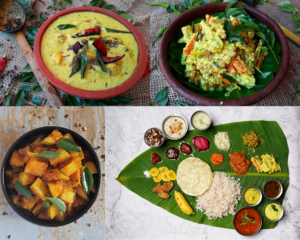 Other famous delicacies on the eve of Onam are-
Other famous delicacies on the eve of Onam are-
 Furthermore, during this month, devotees avoid warfare or any violence since it’s one of the holiest months. It’s the month of remembrance as people honour the martyrs and abstain from joyous events. Also known as the Mourning of Muharram, the Tenth day of Muharram is called the Day of Ashura. While the Shia Muslims mourn the tragedy of Imam Hussein’s family, the Sunni Muslims practice fasting on Ashura. Ashura means ‘Tenth‘ and refers to the tenth day of Muharram. The mourning begins from the first night and climaxes on the tenth night of Muharram.
Furthermore, during this month, devotees avoid warfare or any violence since it’s one of the holiest months. It’s the month of remembrance as people honour the martyrs and abstain from joyous events. Also known as the Mourning of Muharram, the Tenth day of Muharram is called the Day of Ashura. While the Shia Muslims mourn the tragedy of Imam Hussein’s family, the Sunni Muslims practice fasting on Ashura. Ashura means ‘Tenth‘ and refers to the tenth day of Muharram. The mourning begins from the first night and climaxes on the tenth night of Muharram.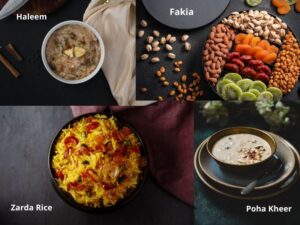

 According to folklore, the Shravana month has a rich history making it auspicious. The ‘Puranas‘ and the ‘Samudra Manthan‘ were extracting ‘Amrit‘. During the process, a deadly poison started to emerge. The Devas and Asuras couldn’t touch it, and it would have meant the end of the universe. However, Lord Shiva drank the poison and stored it in his throat and hence, he received the title ‘Neelkantha‘. Furthermore, to reduce the effects of the poison, the Devas would offer holy water from the Ganges. This story took place during this month, and that’s why it is considered auspicious.
According to folklore, the Shravana month has a rich history making it auspicious. The ‘Puranas‘ and the ‘Samudra Manthan‘ were extracting ‘Amrit‘. During the process, a deadly poison started to emerge. The Devas and Asuras couldn’t touch it, and it would have meant the end of the universe. However, Lord Shiva drank the poison and stored it in his throat and hence, he received the title ‘Neelkantha‘. Furthermore, to reduce the effects of the poison, the Devas would offer holy water from the Ganges. This story took place during this month, and that’s why it is considered auspicious. Indians adhere to a strict vegetarian diet. So, during fasting, you can eat fruits, delicacies consisting sabudana (tapioca), milk and milk products, and bhagar (barnyard millets) but cannot include garlic, onions, and table salt in their diet. You can enjoy dishes like
Indians adhere to a strict vegetarian diet. So, during fasting, you can eat fruits, delicacies consisting sabudana (tapioca), milk and milk products, and bhagar (barnyard millets) but cannot include garlic, onions, and table salt in their diet. You can enjoy dishes like  Teej, like Shravan, is a month full of festivals celebrated by women in Nepal and North India. Women celebrate Haryali Teej and Hartalika Teej to welcome the monsoon.
Teej, like Shravan, is a month full of festivals celebrated by women in Nepal and North India. Women celebrate Haryali Teej and Hartalika Teej to welcome the monsoon.
 Ashadi Ekadashi is one such festive day where the celebration comes in the form of fasting!! This festive day is known by other names such as ‘Shayani Ekadashi‘, ‘Padma Ekadashi‘, Toli Ekadashi in Telugu, and many others. It is the 11th Lunar Day of the Hindu month of Ashada. This day is particularly significant for Vaishnavas, the followers of Lord Vishnu. Moreover, devotees hold a fast during this day to commemorate Lord Vishnu and Lakshmi. People spend the entire night singing prayers, where people keep fast and take vows to be observed during the Chaturmas (four-month period of monsoon).
Ashadi Ekadashi is one such festive day where the celebration comes in the form of fasting!! This festive day is known by other names such as ‘Shayani Ekadashi‘, ‘Padma Ekadashi‘, Toli Ekadashi in Telugu, and many others. It is the 11th Lunar Day of the Hindu month of Ashada. This day is particularly significant for Vaishnavas, the followers of Lord Vishnu. Moreover, devotees hold a fast during this day to commemorate Lord Vishnu and Lakshmi. People spend the entire night singing prayers, where people keep fast and take vows to be observed during the Chaturmas (four-month period of monsoon). Furthermore, this day also observes a huge yatra (a religious procession) of pilgrims known as Pandhapur Ashadi Ekadashi Waari Yatra. Pilgrims come from various parts of Maharashtra to the city of Pandharpur. This city is the center of worship of the deity, Vitthal, a local form of Lord Vishnu. These pilgrims are referred to as Warkaris, and they sing chants dedicated to Saint Tukaram and Saint Dnyaneshwar.
Furthermore, this day also observes a huge yatra (a religious procession) of pilgrims known as Pandhapur Ashadi Ekadashi Waari Yatra. Pilgrims come from various parts of Maharashtra to the city of Pandharpur. This city is the center of worship of the deity, Vitthal, a local form of Lord Vishnu. These pilgrims are referred to as Warkaris, and they sing chants dedicated to Saint Tukaram and Saint Dnyaneshwar.

 They are made of renewable sources and hence, are recyclable and biodegradable
They are made of renewable sources and hence, are recyclable and biodegradable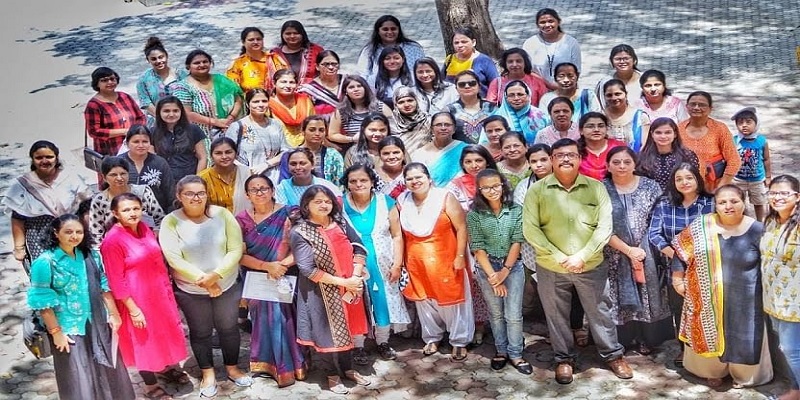
 However, in the present world, food fusion is a common culture among the masses. ‘Westernisation’ of different cultures has led to people losing their grip on their roots. Traditional delicacies that have been in the families for generations are slowly disappearing. But after the pandemic, people have realised the importance of home-cooked food; this has bred a new demand, and slowly, there’s a concept of home-chefs popularising in today’s world. But for
However, in the present world, food fusion is a common culture among the masses. ‘Westernisation’ of different cultures has led to people losing their grip on their roots. Traditional delicacies that have been in the families for generations are slowly disappearing. But after the pandemic, people have realised the importance of home-cooked food; this has bred a new demand, and slowly, there’s a concept of home-chefs popularising in today’s world. But for  “I wanted to give the home-cooks a sense of independence by helping them earn money with the help of their passion of cooking”. Leena was shortlisted in IIM Bangalore because of her concept and was able to make it a scalable model over the course of three years. Now,
“I wanted to give the home-cooks a sense of independence by helping them earn money with the help of their passion of cooking”. Leena was shortlisted in IIM Bangalore because of her concept and was able to make it a scalable model over the course of three years. Now, 
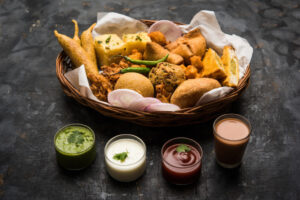
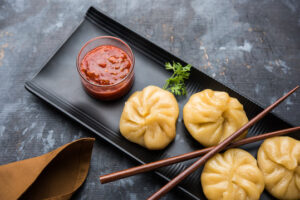



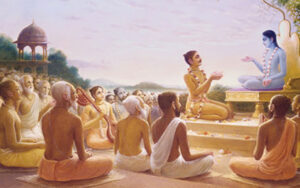


 3. Dhanurasana (Bow Pose) – Stretching the entire body, it aids in weight loss and boosts digestion. It helps make the back flexible and also helps increase the blood circulation in the body.
3. Dhanurasana (Bow Pose) – Stretching the entire body, it aids in weight loss and boosts digestion. It helps make the back flexible and also helps increase the blood circulation in the body. 4. Vakrasana (Twisted Pose) – An intriguing pose, it helps in making the body flexible and reduces belly fat. As it regulates digestive juices, it also helps in improve digestion
4. Vakrasana (Twisted Pose) – An intriguing pose, it helps in making the body flexible and reduces belly fat. As it regulates digestive juices, it also helps in improve digestion 5. Bhujangasana (Cobra Stretch) – This pose basically corrects your posture and makes your spine flexible.
5. Bhujangasana (Cobra Stretch) – This pose basically corrects your posture and makes your spine flexible.